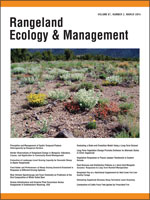Cattle fecal pats readily ignite, are a common source of spot fires, and release extreme amounts of energy when burning. Moreover, dung-dependent livestock parasites can be reduced by combusting fecal pats in prescribed burns. We conducted a study to identify factors that influence combustion of cattle fecal pats. Fifty fecal pats were located in each burn unit before 10 prescribed fires and then rated for combustion after each fire. Combustion of cattle fecal pats was highly variable across fires, with average proportion of combustion of individual pats from the 10 fires ranging from 2 ± 2 to 98 ± 1% (mean ± SE). Of 10 fecal pat, fuel, and weather variables assessed, only fecal pat condition, 10-h time-lag dead fuel moisture (DFM), and fuel load entered as variables in a stepwise selection method of constructing a multiple regression model of combustion of fecal pats (R2 = 0.94, P < 0.01). Condition of fecal pats (a function of elapsed time since deposition, fuel moisture, and decomposition) explained the greatest variation of pat combustion (partial R2 = 0.75), followed by 10-h DFM (partial R2 = 0.12) and fuel load (partial R2 = 0.07). Combustion was < 10% when 10-h DFM exceeded 13% regardless of pat condition. For every 1 Mg · ha−1 increase in fuel load, combustion of older and drier fecal pats increased by about 7%, but combustion of fresh fecal pats always averaged < 20% and was unrelated to fuel load. Our results demonstrate that combustion of pats can be managed to meet a variety of ecological and production goals.
How to translate text using browser tools
1 March 2014
Combustion of Cattle Fecal Pats Ignited by Prescribed Fire
J. Derek Scasta,
John R. Weir,
David M. Engle,
J. D. Carlson
ACCESS THE FULL ARTICLE

Rangeland Ecology and Management
Vol. 67 • No. 2
March 2014
Vol. 67 • No. 2
March 2014
disturbance
ecology
Fuel
grazing
parasites
weather




